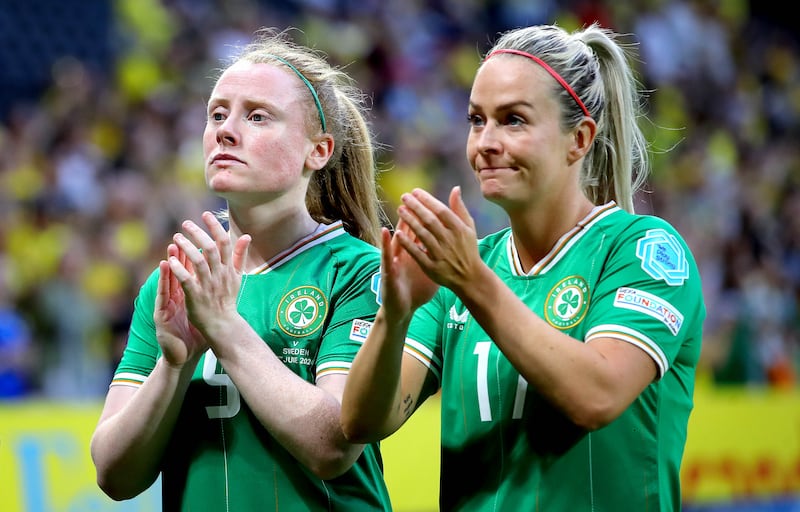Credit where credit is due to Eileen Gleeson and the Ireland management. After being comprehensively beaten 3-0 by Sweden in Dublin last Friday, they changed up for Stockholm.
There was plenty of common sense to a 4-2-3-1 formation. Mainly, it took the heat off Katie McCabe, who was running on fumes after the Arsenal in Australia end of season tour, placing the emphasis on the Irish midfield duo of Megan Connolly and Lily Agg to keep a high line.
Megan and Lily set the tone and Sweden struggled to break us down, until they finally found a way off a late set piece. If not for Troy Parrott’s injury-time finish to beat Hungary, we’d be singing another sad song about Irish football.
There is no shame in losing to Sweden twice in four days. The Irish team reacted to last Friday, they showed renewed organisation and grit against World Cup semi-finalists.
READ MORE
Same goes for the performances against Australia, Canada, France and England in the past 11 months when Ireland held their own but lost. We were brave but glaringly short in terms of technical ability – besides Katie McCabe and Denise O’Sullivan, who became world calibre players in spite of, and not because of, the Irish system.
The girls and Eileen are holding up their end of the bargain but, ultimately, they fell short against a nation that is 20 years further down the road in terms of developing female talent. And 12 months from now, Sweden will be 21 years ahead of us in terms of how they nurture and produce professional footballers.
The FAI published a detailed player pathways plan last February. Great. On the ground, in the seemingly semi-professional League of Ireland, we are not seeing all this big talk turned into reality.

For example, I would like to know where the €500,000 Government bonus, for reaching last year’s World Cup was spent. That is the exact amount needed to run a League of Ireland men’s academy. Half a million every year could fund a scholarship scheme created by the FAI, the Government and universities.
Abbotstown could be turned into a genuine centre of excellence by forming an Irish under-21s squad. The men have this vital age grade under Jim Crawford; is there a legitimate reason for the women not to have a 21s team?
It makes no sense to me.
Streamlined football scholarships to third level education would allow the FAI to treat the World Student Games as the Republic of Ireland’s Olympics. Join the dots and properly develop the 76 per cent increase in female participation since the World Cup.
We are not doing enough to keep these girls in the game. And we know there are deep rooted problems between the SFAI, the Dublin District Schoolgirls League and Metro Girls League.
Abbie Larkin, for one, would instantly benefit from the 21s. Abbie is still only 19 but since 2022 she has moved from Shelbourne to Shamrock Rovers to Glasgow City to Crystal Palace in search of game time as a professional. The Irish system should be doing more to help her progress, either by staying at home or coming back to develop at her age grade.
Ninety-nine per cent of the current Irish squad know that their education is more important than a short term contract with an English, Belgian or US club. There is no pot of gold after 10 years as a female professional footballer.
Nor is there a clear pathway for the best under-14s in the country playing Gaynor Cup to the Ireland senior squad. At 16, girls must be developed enough as athletes to break into a League of Ireland side and hope their form catches the eyes of Glasgow City or Crystal Palace.
Heather Payne was ready to shine for Everton in the Super League this season because of her four years at Florida State. Emigration remains the answer, which is not good enough in 2024. The FAI published a 12 year pathways plans that lacks a visible pathway for girls aged 15 to 21.

In many ways, Abbie Larkin is following Katie McCabe’s career path. She will have to scrap and develop on the fly, like Katie did, to establish herself in the English game. She has the talent but in far too many ways we are not adequately helping our players. Change is promised but enacting it is happening at a glacial pace.
We are seeing more regression than progression. The 17-year-olds at Peamount have a professional mindset that I lacked at their age. They see one route, and it is across the water. Their commitment is far beyond what my generation could afford to give both mentally and physically. They are self motivated because they saw how Katie, Denise, Abbie and Heather found a way.
I began my career as a striker but ended up at centre back because our game encouraged caution over expression. Avoid making a mistake rather than having a go. That ethos is still rooted in the collective psyche of Irish footballers.
Former Ireland manager Colin Bell brought in the weekly sessions for home-based players. Most of us had full-time jobs so it was always a challenge to get across to Blanchardstown on a Thursday night. We all showed up, religiously. It was our only taste of professionalism. Vera Pauw carried on this important gathering, but it has disappeared under Eileen.
No under-21s, no streamlined scholarship scheme to keep players at home, and no sessions for the next generation after under-19. Again and again, we are asking why?
Next comes England at Carrow Road in July, without the suspended Katie McCabe, before this Nations League campaign ends against France at Páirc Uí Chaoimh. Ireland need to remember how to score goals again, so we get through the Euro 2025 play-offs.
If Gleeson can get this squad to the point where they are able to switch systems seamlessly in-game, if we can get a result by hook or by crook, then evidential progress will be visible. Enough plans and promises.















